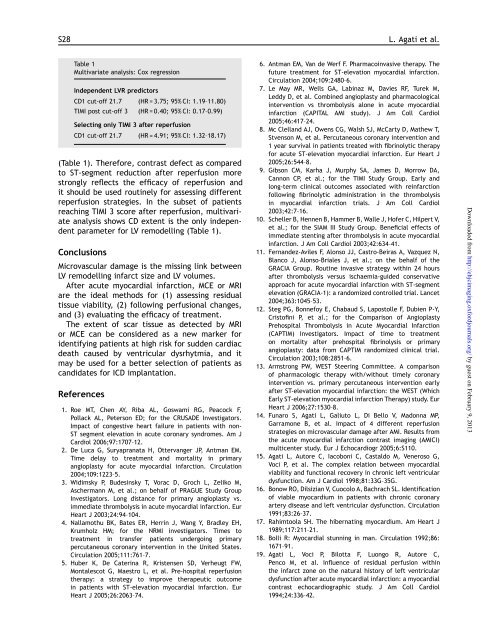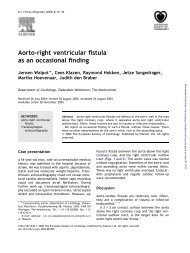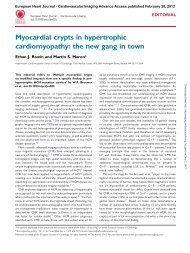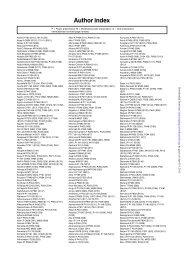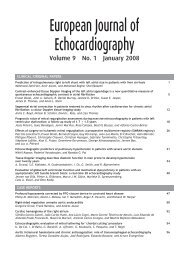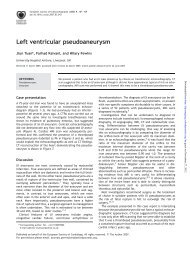Tissue viability by contrast echocardiography - EHJ Cardiovascular ...
Tissue viability by contrast echocardiography - EHJ Cardiovascular ...
Tissue viability by contrast echocardiography - EHJ Cardiovascular ...
You also want an ePaper? Increase the reach of your titles
YUMPU automatically turns print PDFs into web optimized ePapers that Google loves.
S28 L. Agati et al.<br />
Table 1<br />
Multivariate analysis: Cox regression<br />
Independent LVR predictors<br />
CD1 cut-off 21.7 (HR = 3.75; 95% CI: 1.19–11.80)<br />
TIMI post cut-off 3 (HR = 0.40; 95% CI: 0.17–0.99)<br />
Selecting only TIMI 3 after reperfusion<br />
CD1 cut-off 21.7 (HR = 4.91; 95% CI: 1.32–18.17)<br />
(Table 1). Therefore, <strong>contrast</strong> defect as compared<br />
to ST-segment reduction after reperfusion more<br />
strongly reflects the efficacy of reperfusion and<br />
it should be used routinely for assessing different<br />
reperfusion strategies. In the subset of patients<br />
reaching TIMI 3 score after reperfusion, multivariate<br />
analysis shows CD extent is the only independent<br />
parameter for LV remodelling (Table 1).<br />
Conclusions<br />
Microvascular damage is the missing link between<br />
LV remodelling infarct size and LV volumes.<br />
After acute myocardial infarction, MCE or MRI<br />
are the ideal methods for (1) assessing residual<br />
tissue <strong>viability</strong>, (2) following perfusional changes,<br />
and (3) evaluating the efficacy of treatment.<br />
The extent of scar tissue as detected <strong>by</strong> MRI<br />
or MCE can be considered as a new marker for<br />
identifying patients at high risk for sudden cardiac<br />
death caused <strong>by</strong> ventricular dysrhytmia, and it<br />
may be used for a better selection of patients as<br />
candidates for ICD implantation.<br />
References<br />
1. Roe MT, Chen AY, Riba AL, Goswami RG, Peacock F,<br />
Pollack AL, Peterson ED; for the CRUSADE Investigators.<br />
Impact of congestive heart failure in patients with non-<br />
ST segment elevation in acute coronary syndromes. Am J<br />
Cardiol 2006;97:1707–12.<br />
2. De Luca G, Suryapranata H, Ottervanger JP, Antman EM.<br />
Time delay to treatment and mortality in primary<br />
angioplasty for acute myocardial infarction. Circulation<br />
2004;109:1223–5.<br />
3. Widimsky P, Budesinsky T, Vorac D, Groch L, Zeliko M,<br />
Aschermann M, et al.; on behalf of PRAGUE Study Group<br />
Investigators. Long distance for primary angioplasty vs.<br />
immediate thrombolysis in acute myocardial infarction. Eur<br />
Heart J 2003;24:94–104.<br />
4. Nallamothu BK, Bates ER, Herrin J, Wang Y, Bradley EH,<br />
Krumholz HM; for the NRMI investigators. Times to<br />
treatment in transfer patients undergoing primary<br />
percutaneous coronary intervention in the United States.<br />
Circulation 2005;111:761–7.<br />
5. Huber K, De Caterina R, Kristensen SD, Verheugt FW,<br />
Montalescot G, Maestro L, et al. Pre-hospital reperfusion<br />
therapy: a strategy to improve therapeutic outcome<br />
in patients with ST-elevation myocardial infarction. Eur<br />
Heart J 2005;26:2063–74.<br />
6. Antman EM, Van de Werf F. Pharmacoinvasive therapy. The<br />
future treatment for ST-elevation myocardial infarction.<br />
Circulation 2004;109:2480–6.<br />
7. Le May MR, Wells GA, Labinaz M, Davies RF, Turek M,<br />
Leddy D, et al. Combined angioplasty and pharmacological<br />
intervention vs thrombolysis alone in acute myocardial<br />
infarction (CAPITAL AMI study). J Am Coll Cardiol<br />
2005;46:417–24.<br />
8. Mc Clelland AJ, Owens CG, Walsh SJ, McCarty D, Mathew T,<br />
Stvenson M, et al. Percutaneous coronary intervention and<br />
1 year survival in patients treated with fibrinolytic therapy<br />
for acute ST-elevation myocardial infarction. Eur Heart J<br />
2005;26:544–8.<br />
9. Gibson CM, Karha J, Murphy SA, James D, Morrow DA,<br />
Cannon CP, et al.; for the TIMI Study Group. Early and<br />
long-term clinical outcomes associated with reinfarction<br />
following fibrinolytic administration in the thrombolysis<br />
in myocardial infarction trials. J Am Coll Cardiol<br />
2003;42:7–16.<br />
10. Scheller B, Hennen B, Hammer B, Walle J, Hofer C, Hilpert V,<br />
et al.; for the SIAM III Study Group. Beneficial effects of<br />
immediate stenting after thrombolysis in acute myocardial<br />
infarction. J Am Coll Cardiol 2003;42:634–41.<br />
11. Fernandez-Aviles F, Alonso JJ, Castro-Beiras A, Vazquez N,<br />
Blanco J, Alonso-Briales J, et al.; on the behalf of the<br />
GRACIA Group. Routine invasive strategy within 24 hours<br />
after thrombolysis versus ischaemia-guided conservative<br />
approach for acute myocardial infarction with ST-segment<br />
elevation (GRACIA-1): a randomized controlled trial. Lancet<br />
2004;363:1045–53.<br />
12. Steg PG, Bonnefoy E, Chabaud S, Lapostolle F, Dubien P-Y,<br />
Cristofini P, et al.; for the Comparison of Angioplasty<br />
Prehospital Thrombolysis in Acute Myocardial Infarction<br />
(CAPTIM) Investigators. Impact of time to treatment<br />
on mortality after prehospital fibrinolysis or primary<br />
angioplasty: data from CAPTIM randomized clinical trial.<br />
Circulation 2003;108:2851–6.<br />
13. Armstrong PW, WEST Steering Committee. A comparison<br />
of pharmacologic therapy with/without timely coronary<br />
intervention vs. primary percutaneous intervention early<br />
after ST-elevation myocardial infarction: the WEST (Which<br />
Early ST-elevation myocardial infarction Therapy) study. Eur<br />
Heart J 2006;27:1530–8.<br />
14. Funaro S, Agati L, Galiuto L, Di Bello V, Madonna MP,<br />
Garramone B, et al. Impact of 4 different reperfusion<br />
strategies on microvascular damage after AMI. Results from<br />
the acute myocardial infarction <strong>contrast</strong> imaging (AMICI)<br />
multicenter study. Eur J Echocardiogr 2005;6:S110.<br />
15. Agati L, Autore C, Iacoboni C, Castaldo M, Veneroso G,<br />
Voci P, et al. The complex relation between myocardial<br />
<strong>viability</strong> and functional recovery in chronic left ventricular<br />
dysfunction. Am J Cardiol 1998;81:33G–35G.<br />
16. Bonow RO, Dilsizian V, Cuocolo A, Bachrach SL. Identification<br />
of viable myocardium in patients with chronic coronary<br />
artery disease and left ventricular dysfunction. Circulation<br />
1991;83:26–37.<br />
17. Rahimtoola SH. The hibernating myocardium. Am Heart J<br />
1989;117:211–21.<br />
18. Bolli R: Myocardial stunning in man. Circulation 1992;86:<br />
1671–91.<br />
19. Agati L, Voci P, Bilotta F, Luongo R, Autore C,<br />
Penco M, et al. Influence of residual perfusion within<br />
the infarct zone on the natural history of left ventricular<br />
dysfunction after acute myocardial infarction: a myocardial<br />
<strong>contrast</strong> echocardiographic study. J Am Coll Cardiol<br />
1994;24:336–42.<br />
Downloaded from<br />
http://ehjcimaging.oxfordjournals.org/ <strong>by</strong> guest on February 9, 2013


